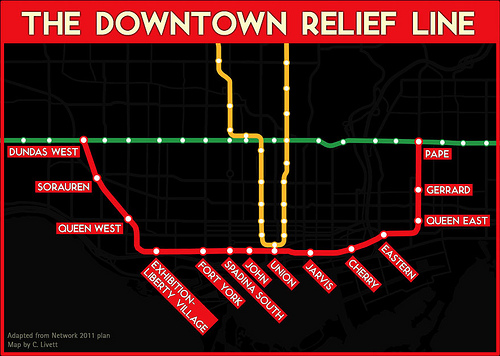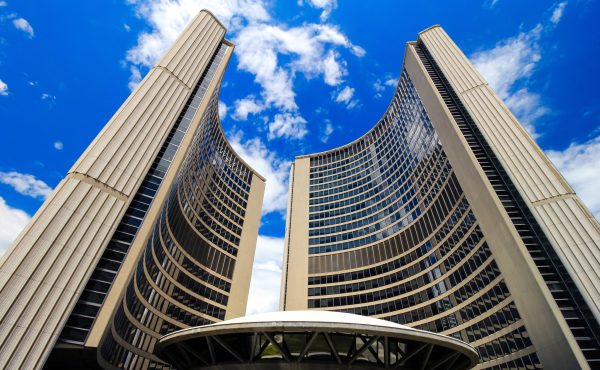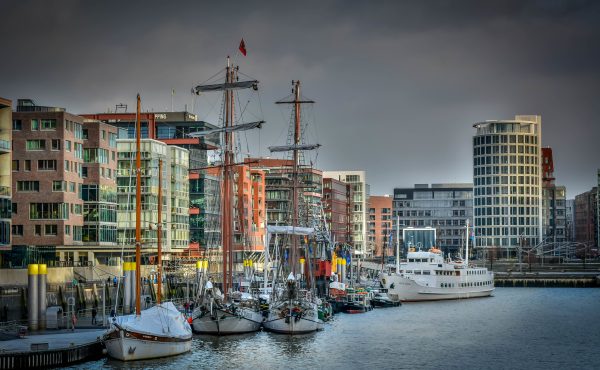
Here’s a quirky coincidence: The future of the Downtown Relief Line (DRL) rests, at the moment, in the hands of six women — three politicians and three senior civil servants.
On the decision-making side, we have TTC chair Karen Stintz, as well as the newly-minted premier Kathleen Wynne and NDP leader Andrea Horvath, who appears to be holding the keys to the Liberals’ tentative hold on power.
On the bureaucratic side sits the city’s new chief planner Jennifer Keesmaat, who has come out swinging on the transit file, as well as two top officials at the TTC and Metrolinx — respectively, Anna Pace, director of strategic partnerships, and Leslie Woo, vice-president planning and policy. (The latter two have extensive experience in long-range planning and inter-governmental relations.)
So what?
First, I’ve attended enough transit planning panel discussions and meetings to say with some confidence that the attendees typically skew male, and sometimes quite conspicuously so. So the fact that there are so many senior women driving the conversation is certainly anomalous.
Second, to the extent that women may be inclined towards a less confrontational form of politics, this gender alignment could, in theory, have a great deal of significance in the evolution of the debate over this long-overdue (first bruited in 1985) expansion of the subway system.
The reason, quite simply, is that while the TTC/City of Toronto and Metrolinx both say they favour a DRL and see it as a high priority project, the two institutions at present have distinctly different visions for the alignment of this new line, as well as its raison d’etre.
The TTC, last fall, unveiled the Downtown Relief Transit Expansion Study to scope out the alignment of a proposed downtown relief line, to run in a broad U south from the Bloor and Danforth lines and intersecting with the Yonge-University loop. It could also include an extension up to Don Mills and Eglinton. According to Pace, the TTC is now gearing up for an accelerated environmental assessment on the proposed line, which will be completed later in the year or early 2014.
Metrolinx, also last fall, revealed that it had decided to accelerate plans to build a downtown relief line, as well as the extension of the Yonge subway up to Richmond Hill. But when the agency — which is investigating options for dealing with post-2025 overcrowding at Union Station — talks about a DRL, it has something quite different in mind than the TTC does.
As this fact sheet indicates, the route might head to the CNE, as suggested in a Metrolinx study proposing a connection between a DRL and a new GO commuter rail station near Front and Bathurst (see page 12 in this report). Whatever the alignment, the new line could serve 107 million riders by 2031, says Metrolinx, which is also looking at expanding GO service along Lakeshore as means of relieving crowding on the Yonge-University-Spadina line.
Both agencies are now proceeding with their own technical analyses, and everyone, of course, is waiting with baited breath for looming political decisions about the funding of such projects, as well as others across the GTA.
The question is whether these apparently parallel planning processes will converge, and if so, how and when. I asked Stintz, Pace, Keesmaat and Woo (via a Metrolinx spokesperson) this question and they all insisted that the two agencies are well aware of what the other is doing. Pace described the planning as “complementary” and underscored the fact that it is actually underway. “I’m feeling more confident than I was in the past because a lot of work is being done.”
“The City and Metrolinx work is not far apart,” stresses Woo, who adds that the TTC, Metrolinx and the City of Toronto have agreed to produce over the next 12 to 18 months a much more granular analysis of a proposed line, with an eye to ensuring that downtown capacity is met, the region-wide impact is “positive” and that the Yonge north expansion can be built without overwhelming the downtown portion of the subway system.
“Our understanding is that Metrolinx will work collaboratively with the local municipalities,” adds Keesmaat, who expects the Feeling Congested consultation to lead to a fall report linking future funding tools and future TTC expansion plans. But, she concedes, “We’re fully aware that we’re running on parallel tracks. We’re trying to talk as much as possible. Are we there yet? Absolutely not.”
How this all gets resolved is by no means clear; indeed, much will depend not just on new funding, but where exactly the money comes from. Stintz argues that the City of Toronto has to establish its own revenue tools if it wants to influence the outcome of what eventually gets built. Metrolinx, in turn, will release its investment strategy and revenue tool recommendations in late May, but the ultimate decision rests with the provincial cabinet. And don’t forget the Harper government, which will likely be unveiling new federal infrastructure program in a month or two.
Wynne, lest anyone forget, cut her teeth in politics in the mid-1990s, with John Sewell’s Citizens for Local Democracy group, which espoused the importance of municipal decision-making in the face of unwelcome edicts from the Pink Palace.
But it remains to be seen whether she’s around to make this call, and whether she’ll be able to encourage the City/TTC and Metrolinx to hammer out a genuine consensus.
The broader point, however, is that transit users in Toronto, as well as those in the 905 who come downtown, want policy-makers to serve up a single, well-constructed solution, not two that appear to be in conflict with one another and set the stage for more years of political brinksmanship.
At the moment, two sets of planners are working on two sets of plans to solve one murderously difficult transportation problem, and no one knows who’s going to pay the bill. It’s tough to imagine a better time for a collaborative approach.





11 comments
A Queen subway running up Don Mills was studied in the 1970s, and even that wasn’t the first incarnation of the scheme. See:
http://stevemunro.ca/?p=2481
Also I presume you meant to say that the accelerated EA would be completed in early 2014, not 2013.
Lower Queen Station has a strange fascination for people drawing lines on maps, but it dates from a much earlier proposal for a streetcar subway on Queen from 1945.
http://stevemunro.ca/?p=93
The idea of going northeast and northwest shows up in 1968 as described in this TTC report from June of that year:
It is to be noted that the staff of Metropolitan Toronto Planning Board have recently completed a report on rapid transit priorities for Metropolitan Toronto – 1968. The report recommends, “further study of Queen Street Subway extending from an easterly terminal on Greenwood Avenue and O’Connor Drive, South on Greenwood to Queen Street, West on Queen Street to the Weston rail line at Dufferin Street, and from that point in a North-Western direction on the rail line to a Western point at about Islington Avenue.”
I don’t see a conflict between the visions. While Bloor-Yonge is over capacity, St. George is still under capacity. The relief is needed in the East, not the West. If Metrolinx needs the line to also swerve south to a terminus at Spadina and Front (“Bathurst” Yard), there’s no reason for TTC to object. Liberty Village denizens might be unhappy, but they weren’t going to get a subway line in Phase 1 of the DRL regardless.
There is no technology conflict, as both Metrolinx and TTC are assuming a TTC subway tunnel. Metrolinx ruled out a GO train tunnel through downtown, while the demand is too high for LRT.
> According to Pace, the TTC is now gearing up for an accelerated environmental assessment on the proposed line, which will be completed later in the year or early 2013.
I think you mean 2014.:-)
I agree the east is a priority for a DRL. However just because St. George is not “at capacity” today does not mean it won’t be in a few years especially once the YUS extension to Vaughan is complete. I waited for 4 trains last week one morning at Museum station heading southbound – each train was completely packed. In a wealthy, developed city like TO, that’s just not normal.
St George may be ‘under capacity’ by some analyst’s measure, but anyone who’s been on the platform during a rush hour delay would disagree. It’s dangerously crowded as it is.
Retrofitting the lower Queen Subway for a DRL maybe problematic, for both heavy or light rail use. Both heavy and light rail vehicles would be too wide to make use of the lower station, as is. The original design was to use PCC streetcars as the vehicles for the Queen Subway.
The Bombardier Freedom light rail vehicle, to be used for Transit City, are of 2.65 m (8’8½’’) wide. Wider than our current streetcars (2.54 m).
The Toronto heavy rail vehicles are 3.150 m (10′ 4”) wide.
I’m currently 47. When I first began following the DRL proposal I had just turned 20. To be honest, I really don’t care any more.
I don’t see the two plans as being that divergent really. Metrolinx’s primary concern is relieving Union Station while the TTC’s is relieving the Yonge subway line (primarily Yonge-Bloor Station). Both see the added benefit of providing another high-order means into the core, regardless of what is being relieved in the process. Therefore, so long as the line provides an opportunity for those from the east to bypass Yonge-Bloor (which it will) and so long as the line can connect to a new Union Station West (which it might) the two plans are aren’t really dueling, but complimentary.
It doesn’t really matter what you do people will keep on trying to fill up whatever new space you create. Better to just leave it overcrowded so as not to encourage them.
It’s funny and sad to see the ttc and Metrolinx are running their DRL plans on separate tracks.
What this city and region really need is clear cooperation between the ttc and Metrolinx … On funding, operations and planning.
It seems that an East DRL is the priority now. It seems both lines intend to reach the Exhibition Grounds. Let’s agree on that core routing and build that as soon as possible, then look at ways to expand service.
Let this be the real start of TTC+GO/Metrolinx cooperation
Cheers, Moaz
While a relief line is needed, rather than simply resuscitating the lines drawn at least 30 years ago, I would argue that sufficient relief that the city needs for the future should run further north and east. I don’t pretend to know exact routing but I would think going up as far as the Sheppard LRT will make sense by the time this is built and likewise a true relief of the BDL will require intercepting it further east (with my personal preference being that it would also tie into the LSE Go line (ie. Main).
Get rid of the queen streetcar and put a subway there instead. Will solve problems with traffic and subway congestion.